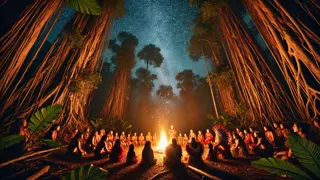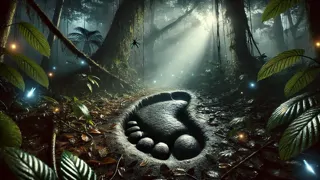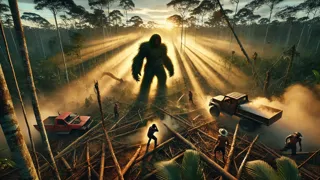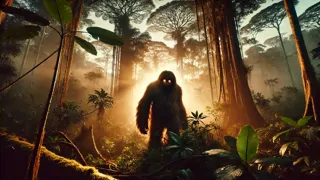Introduction
Under a veil of drifting mist, the Amazon rainforest pulses with life, a living tapestry woven by insects, birds, and the whisper of ancient trees. For centuries, local tribes have spoken in hushed tones about a colossal presence lurking within the dense foliage—a beast so vast that it reshapes the earth with every footfall. They call it the Mapinguari, guardian of the green heart, whose shaggy coat blends seamlessly with moss-laden trunks and whose roar echoes through hidden valleys. Elders pass down tales of how this creature emerged from the earth itself, born of the forest’s deepest magic to shield the Amazon from those who would ravage its sanctuaries. When loggers’ axes threaten to topple sacred groves or miners scar riverbanks, villagers believe the ground will quake and ancient fury will rise to defend the land. This legend, carried on the wind and sung in ceremonial chants, weaves together the wisdom of ancestors, the fragility of ecosystems, and the unwavering spirit of nature. In their songs, the Mapinguari is neither villain nor mere monster, but a solemn protector—reminding all who wander beneath the emerald canopy that the jungle is alive, aware, and prepared to fight for its survival. Today, as the Amazon faces unprecedented threats, the legend endures, calling out across torrents and treetops, a rallying cry for unity between people and the forest they share. As dawn unfurls golden light through towering kapok trees, the forest awakens to a chorus of trumpeting macaws and crooning toucans, each note a testament to life’s resilience. Beneath the canopy, sculpted roots cradle rare orchids and steer clear streams that gleam with the reflection of emerald leaves overhead. Yet beyond this vibrant tableau lies a story of balance and retribution, for when humankind’s ambition tiptoes too close, the earth answers with thunderous steps. Across distant riverbanks and in the hush of moonlit glades, signs of the Mapinguari—massive footprints, torn vines, and low vibrations in the soil—stir wonder and unease. Scholars and conservationists, drawn by local lore, venture into unexplored backcountry, driven by the hope of glimpsing this mythic beast and by a deeper yearning to protect the Amazon’s fragile wonders.
Whispers of an Ancient Protector
Long before the first European ships navigated the Amazon’s winding waterways, indigenous peoples spoke of a guardian born from earth and spirit. According to elders, when a shaman crushed a sacred seed beneath his sandal, the forest’s heart answered by summoning a single, thunderous heartbeat in the ground. From that pulse rose the Mapinguari, a beast with scales of bark and breath of river fog, destined to watch over every leaf and living creature. The people learned to honor the beast with ceremonial dances at the full moon, painting their skins with red clay and decorating their hair with hummingbird feathers. In return, the Mapinguari promised protection against hostile forces—poachers, greedy loggers, or any who sought to despoil the canopy’s harmony.

Generation after generation, the story changed hue and detail, yet its core remained: a formidable presence that could summon tremors when the forest cried out in pain. Children listened wide-eyed to tales of how, once, the beast ripped apart a clandestine logging camp that dared scar the heart of an ancient grove, leaving twisted trees and snapped axes in its wake. Hunters emerging from the undergrowth would sometimes swear they caught a glimpse of fiery eyes reflected by a sudden thunderclap, only to find bent branches and toppled palm trees in the creature’s silent wake. Around flickering hearths deep within woven-leaf huts, storytellers urged the next generation to tread lightly and respect each root and river, for the forest watched, and so did its guardian.
Despite these warnings, time pressed on and the outside world’s appetite for resources gnawed ever deeper. Missionary patrols, rubber-collectors, and curious naturalists arrived in the 20th century, each with their own agenda. While some chronicled the vivid biodiversity—poison dart frogs, jaguars, and macaws—the Mapinguari remained an enigma. Photographic plates turned up only blurred imprints, and scientific journals labeled eyewitness accounts mere myth. Yet local shamans quietly maintained their faith, tending to the old ways in hidden groves and leaving offerings of cassava bread and river fish on mossy stones. Only after dusk, under moonlight, did they whisper prayers to the ancient protector whose low, resonant roar seemed to shake the heavens and remind all living things that the Amazon’s heart would not be silenced without a fight.
Shadows in the Canopy
When dawn breaks over a forgotten tributary, the canopy above shivers with anticipation. In these remote reaches, modern encroachment arrives in stealth—not with the roar of machines, but as clandestine chainsaws and illicit roads pushing deeper into emerald wastes. Satellite images reveal scars where once ancient trees stood, and park rangers scramble to protect endangered harpy eagles and pink river dolphins. Yet in the dead of night, as predators stir and insects hum their songs, a far more ancient force awakens. Native biologists, called by faint seismic tremors, have recorded low-frequency vibrations that echo through clutching webs of roots like a primordial heartbeat. Those who dare to investigate discover torn vines that look as though twined vines have been shredded by colossal claws, and massive footprints buried under damp leaf litter.

Journalist Mariana Luz, drawn by rumors of this subterranean hubbub, trekked miles beyond marked trails with a team of trackers from the Yawanawá community. They passed under strangler figs and over braided vines, until the forest opened onto a glade so quiet it seemed otherworldly. There, in a pool of sunlight, lay shreds of bark larger than Mariana’s forearm, and circular depressions that might have held the weight of an ox double its size. That night, between downbeats of distant thunder—whether storm or creature, none could tell—they glimpsed a hulking silhouette, its fur mottled like rotting wood, moving like a phantom through the undergrowth. Mariana’s pulse thudded in her ears as she raised her camera, only to freeze when the eyes gleamed in the darkness—then vanished as quick as breath.
In the following weeks, indigenous communities reported the River of Spirits running thick and blue, fish avoiding the banks as though sensing danger. Rumors spread that the Mapinguari, roused by the desecration of ancestral hunting grounds, had moved closer to human settlements. Some villagers fled in fear, but others gathered offerings at forest edges—piles of manioc and freshwater crabs—hoping to appease the guardian and ask for forgiveness on behalf of loggers passing through. Conservation groups began including the legend in their outreach, branding the Mapinguari a living emblem of resistance. T-shirts bearing its silhouette and pamphlets in Portuguese, English, and indigenous dialects told the tale of a creature for which the jungle itself would stand. But for many, science and legend remained uneasy bedfellows, each demanding proof the other could not fully deliver.
Battle for the Green Heart
It was in the lingering haze of dawn that the first chainsaw roared within sight of the Mapinguari’s ancient grove. Workers thrust forward, axes swinging at bark thick as a man’s torso, and logging trucks roared onto temporary roads carved through virgin wood. Deforestation crews cheered at the cleared corridors, unaware that they trod upon sacred ground. In a nearby canoe, villagers watched in dread as echoing clanks signaled the forest’s unraveling. But then came a tremor that rattled oars and wildlife alike. Palms ripped themselves loose from the soil, prostrate cabins split in half, and a guttural roar, deep and resonant, shook the horizon.

Men fell silent, listening as the earth thundered and the sun’s rays flickered through a cloud of rising debris. As dust swirled, a towering figure emerged: broad shoulders braced against the skyline, eyes burning ember-red, and claws gouging furrows in the earth with every swipe. Workers scrambled in terror, chainsaws dropped to the mud, and trucks reversed in frantic retreat. In a matter of heartbeats, half-burned stumps vanished as if swallowed by living wood, and the air thrummed with the pulse of a guardian awakened.
Across the clearing, representatives from a nearby eco-lodge—scientists, journalists, and indigenous leaders—stood in awe. For a fleeting moment, academia and tradition met in silent agreement: the Mapinguari was real, a force of nature beyond classification, and the Amazon’s loyalty lay with its mystic protector. When the rumble subsided, the beast receded into the shadows, leaving only twisted vines and uprooted trunks in its wake. In that trance of reverence, humanity glimpsed both the ferocity and fragility of the world it had endangered.
In the days that followed, global headlines blared the incident as either an animal unknown or an elaborate hoax. But on the ground, a wave of conservation momentum swept through local towns, indigenous territories, and international audiences. Sustainable forestry initiatives gained new urgency; river cleanup campaigns attracted volunteers; and cultural festivals honored the Mapinguari in song and dance. The beast’s legend, once confined to tribal lore, had become a clarion call—a living symbol that the Amazon would not yield its ancient heartbeat without a fight. As chainsaws quieted and seedlings found purchase in the loamy soil, the forest began to heal, safeguarded by an alliance crafted in awe, belief, and respect.
Conclusion
By the riverbank, where sunlight filters through vines heavy with orchids, the forest speaks once more in a language of chorus and color. The Mapinguari, unseen yet ever present, has etched its legacy upon the land and our collective conscience. Scientists continue to debate its taxonomy, while indigenous custodians whisper fresh prayers of gratitude. Conservationists draw strength from the legend’s resurgence, planting native trees beneath the shade of kapoks that might yet shelter the guardian’s tread. And in every droplet that ripples down an untouched creek, in every cicada’s midnight symphony, the Amazon pulses with a promise: as long as we remember to honor its ancient rhythms, it will stand—diverse, resilient, and defended by a mythic beast whose heart and purpose mirror our own.



















